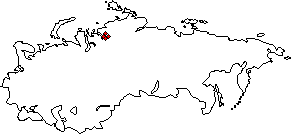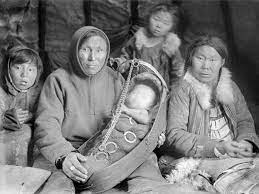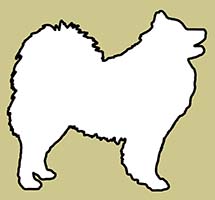The Enets

Enets (enet’-enche) is the self-designation of this ethnic group the original meaning of which is ‘a human being, a man’. In most cases the adjective enej — onaj (real, genuine) is added; i.e. enej enet or ‘Enets, a real human being’. In a similar manner the Enets language is called onaj bazaan ‘a real, genuine language’. The name Enets was first used by a linguist and ethnologist, G. Prokofiev, in 1937. It is a version of the pronunciation of nenets.
An earlier and better known name for the Enets was the Yenisey Samoyeds, derived from their habitat on the Yenisey. This name is still widely used outside the Soviet Union. The general name Samoyed was first used in a chronicle by Monk Nestor. It has been suggested that the word has its origins in the somatu or samatu, used by the Selkup to denote the Enets. Another theory has it as a non-Russian word of unknown origin. The Bai tribe on the Ob has been mentioned in another Russian chronicle (the 11th century).
Habitat. The Enets inhabit the east bank of the River Yenisey in the western part of the Taimyr Peninsula. They belong to the Dudinka and Ust-Yenisey Districts of the Taimyr Autonomous Territory in the Krasnoyarsk region. It is a polar permafrost area, mostlytundra and tundra mountains. The maximum temperature in summer is —13 °C and the average temperature in winter is —30 °C. The Tundra Enets move in an area between the Yenisey and the Pyassina while the Wood Enets live to the north in the centre of the Dudinka territory, in wooded tundra.
Population. The Enets are the smallest Samoyed ethnic group. Since the census of 1926, there has unfortunately been no further exact data on their numbers gathered. The situation has, however, improved in recent years.
| Year | Population | Native Speakers |
| 1926 | 378 | |
| 1959 | 18 (note next paragraph) | |
| 1962 | 300-400 | |
| 1979 | ~ 300 | |
| 1989 | 209 | 45.5% |
In 1959 only 18 Enets were officially registered in the Taimyr Autonomous Territory. This was the result of ignorance; a part of the Enets were registered as Nenets, and another part as Nganasans. Following this debacle, the census was carried out by an ethnologist, V. Vasilyev, and the result this time was “over 300”. The population of the Enets had probably stood at “about 300” for several decades.
As late as 1974 the density of population on the Taimyr was low (42,000 inhabitants per 862,100 square kilometres). In recent years, however, the population has doubled. The native people are more alarmed by the ruinous economic influence and pollution introduced by the newcomers, than by the numbers they have arrived in.
Anthropologically, the Enets belong to the Uralic race. Mongoloid and Arctic features are predominant, with only a minor European influence observable. They have broad faces, high cheekbones and slit eyes. Their hair and eyes are dark, and their skin is swarthy. The average height of the male Enets is less than 160 cm. They have no facial hair.

Language. The Enets language belongs to the northern group of the Samoyed languages, part of the Uralic family of languages. The Enets language is divided into two dialects, the vocabularies of which differ considerably. The dialects are spoken in two different Enets habitats: the Tundra Enets form a majority and speak bai or ‘tundra’ dialect, while the Wood Enets speak madu or ‘wood’ dialect. In addition to these there is also a small group known as the Karastin Enets (Mugadi and Yuchi tribes), who speak partly bai, partly madu. Their language has not been researched. The Enets generally prefer to call themselves by their tribal designations.
In the Dudinka district, the Enets have lived side by side with the Nganasans and the Nenets, and in the Ust-Yenisey district, alone with the Nenets. The languages have influenced each other. Words connected with hunting have been borrowed from the Nganasan language, and terms concerned with reindeer rearing have been taken from Nenets. The Enets language has also been influenced by the Dolgan, the Evenk and the Russian languages.
Mixed marriages have played an important role in the linguistic processes of the Taimyr Peninsula. In former times the Enets married only with the Nganasans, their closest neighbours, but later marriages also took place with the Nenets, the Dolgans and the Evenks. In spite of the multilingualism of the area, the partners in mixed marriages tended to use the Nenets language, a lingua franca of the people in the area.
Owing to the influence of ideology and culture, Russian started to spread rapidly in the 1930s. The growth of Enets as a language has been stunted by an excessive number of loans. It is quite common for people speaking Enets to switch over to Russian or to incorporate Russian words, sentences or phrases.
History. When the unity of the Uralic languages disintegrated, the ancestors of the Samoyedic people separated from the Finno-Ugric tribes. At first they inhabited the areas west of the Urals, in the neighbourhood of the Finno-Ugric people, but later they moved to the east and northeast. The Enets come from the northern group of the Samoyedic people. They started to branch off in the second half of the first millennium.
The Enets consider themselves to be the indigenous inhabitants of the Taimyr Peninsula. According to their legends, the Nenets arrived there later from the Yamal Peninsula. Together with the Nganasans they fought to prevent the Nenets from settling. Due to their marginal area of habitation, the Russians remained unaware of the Enets long after they knew of the Ob-Ugric people and even the Nenets. Although Christianization occurred in the 18th century it was very superficial, and shamanism and animism have survived until the present day.
The main spheres of activity for the Enets have always been hunting and fishing. They have also been nomadic people, dependent on the rhythms of their environment. Before collectivization, they roamed the right bank of the River Yenisey (the Nenets roamed the left bank). In summer they gathered food, firewood, and the material for their winter houses and clothes. Like the Nenets, they domesticated a number of reindeer and used them as draught animals.
Under Soviet rule the life of the Enets changed considerably. During collectivization the process of transforming the Enets into a settled people began, and that turned their whole life upside down. They no longer had any right to reindeer and their pastures. In boarding schools, children became estranged from their native language, and had to re-learn speech in Russian. Since the 1960s the influx of immigrants has increased and large industrial enterprises have been built. A large gas company and its employees — migrants, road builders, lorry drivers, builders — are the masters in the land of the Enets.
They are the representatives of industry and the Russian language. They are also transitory inhabitants uninterested in the environment, which they devastate, burn and pollute. They despise the native people.
Writing. Until recent times, the Enets had no written language. In their relations with other ethnic groups they used Nenets, and at school and in the field of culture, Russian.
In 1986 N. Tereshchenko compiled and published the Enets Cyrillic alphabet (39 characters), and the bai dialect was taken as a basis for the new literary language. Unfortunately no information exists on how the native speakers use their literary language.
Research. For a long time the Enets language was considered to be just a dialect of Nenets. The first records were published in a comparative dictionary by P. S. Pallas (Linguarum totius orbis vocabularia comparativa, 1787–89). The first Samoyed grammar (Grammatik der samojedischen Sprachen, 1854) and the first Samoyed dictionary (Wörterverzeichnis aus den samojedischen Sprachen, 1855) published by M. A. Castrén, both contain some material on the Enets language. This century a little more attention has been paid to the Enets. In a collection on the languages and written texts of the Nordic people, G. Prokofiev published a survey of the Enets language, A. J. Joki published a small dictionary of Northern Samoyedic languages in 1956 (Kleinere Wörterverzeichnisse aus dem Jurak-, Jenissei- und Tawgi-Samojedischen). An ethnological survey was published in 1970 by B. Dolgikh
